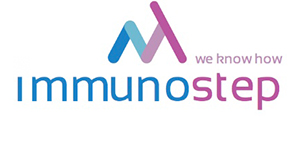CD326 (EpCAM)
CD326 (EpCAM), Monoclonal, IgG1, Host: Mouse, APC
Artikelnummer
IMS326A-100T
Verpackungseinheit
100 Tests
Hersteller
Immunostep
Verfügbarkeit:
wird geladen...
Preis wird geladen...
Clone: VU-1D9.
Conjugate: APC.
Immunogen: Human small cell lung carcinoma cell line NCl-H69.
Storage Buffer: The reagent is provided in aqueous buffered solution containing protein stabilizer, and ≤0.09% sodium azide (NaN3).
Recommended Usage: CD326, clone VU-1D9, is a mAb intended for the identification of bone marrow, colon, lung, and most normal epithelial cells. Also highly expressed on carcinomas of gastrointestinal origin. Expressed during early erythrogenesis.
Description: The VU-1D9 monoclonal antibody reacts with the human CD326 is also known as Ep-CAM, tumor associated calcium signal transducer 1, epithelial cell surface antigen, epithelial glycoprotein 2, EGP2, adenocarcinoma associated antigen, and TROP1. This cell surface glycosylated 40 kD protein is highly expressed in bone marrow, colon, lung, and most normal epithelial cells and is expressed on carcinomas of gastrointestinal origin. Recently, it has been reported that CD326 expression occurs during the early steps of erythrogenesis. CD326 functions as a homotypic calcium-independent cell adhesion molecule and is believed to be involved in carcinogenesis by its ability to induce genes involved in cellular metabolism and proliferation. CD326 antigen is an immunotherapeutic target for the treatment of human carcinomas is a type I transmembrane protein containing six disulfide bridges and one THYRO domain.
CD326 functions as a homotypic calcium-independent cell adhesion molecule and is believed to be involved in carcinogenesis by its ability to induce genes involved in cellular metabolism and proliferation. CD326 antigen is an immunotherapeutic target for the treatment of human carcinomas.The antigen is being used as a target for immunotherapy treatment of human carcinomas. CD326 binds LAIR-1 (CD305) and LAIR-2 (CD306) to inhibit cellular activation and inflammation. This epithelial glycoprotein is now recognized as having an important role in tumor biology.
Conjugate: APC.
Immunogen: Human small cell lung carcinoma cell line NCl-H69.
Storage Buffer: The reagent is provided in aqueous buffered solution containing protein stabilizer, and ≤0.09% sodium azide (NaN3).
Recommended Usage: CD326, clone VU-1D9, is a mAb intended for the identification of bone marrow, colon, lung, and most normal epithelial cells. Also highly expressed on carcinomas of gastrointestinal origin. Expressed during early erythrogenesis.
Description: The VU-1D9 monoclonal antibody reacts with the human CD326 is also known as Ep-CAM, tumor associated calcium signal transducer 1, epithelial cell surface antigen, epithelial glycoprotein 2, EGP2, adenocarcinoma associated antigen, and TROP1. This cell surface glycosylated 40 kD protein is highly expressed in bone marrow, colon, lung, and most normal epithelial cells and is expressed on carcinomas of gastrointestinal origin. Recently, it has been reported that CD326 expression occurs during the early steps of erythrogenesis. CD326 functions as a homotypic calcium-independent cell adhesion molecule and is believed to be involved in carcinogenesis by its ability to induce genes involved in cellular metabolism and proliferation. CD326 antigen is an immunotherapeutic target for the treatment of human carcinomas is a type I transmembrane protein containing six disulfide bridges and one THYRO domain.
CD326 functions as a homotypic calcium-independent cell adhesion molecule and is believed to be involved in carcinogenesis by its ability to induce genes involved in cellular metabolism and proliferation. CD326 antigen is an immunotherapeutic target for the treatment of human carcinomas.The antigen is being used as a target for immunotherapy treatment of human carcinomas. CD326 binds LAIR-1 (CD305) and LAIR-2 (CD306) to inhibit cellular activation and inflammation. This epithelial glycoprotein is now recognized as having an important role in tumor biology.
| Artikelnummer | IMS326A-100T |
|---|---|
| Hersteller | Immunostep |
| Hersteller Artikelnummer | 326A-100T |
| Verpackungseinheit | 100 Tests |
| Mengeneinheit | PAK |
| Reaktivität | Human |
| Klonalität | Monoclonal |
| Methode | Flow Cytometry |
| Isotyp | IgG1 |
| Human Gene ID | 17075 |
| Wirt | Mouse |
| Konjugat | Conjugated, APC (Allophycocyanin) |
| Produktinformation (PDF) | Download |
| MSDS (PDF) | Download |

 English
English






